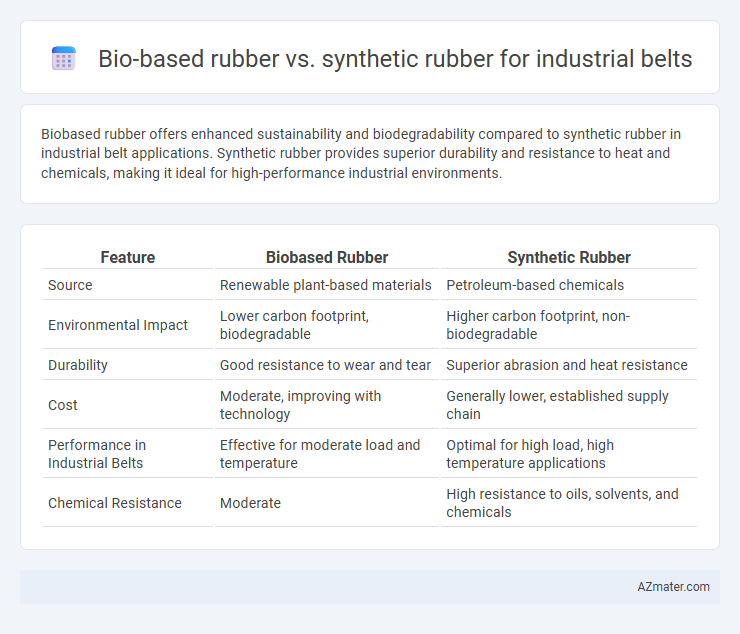Biobased rubber offers enhanced sustainability and biodegradability compared to synthetic rubber in industrial belt applications. Synthetic rubber provides superior durability and resistance to heat and chemicals, making it ideal for high-performance industrial environments.
Table of Comparison
| Feature | Biobased Rubber | Synthetic Rubber |
|---|---|---|
| Source | Renewable plant-based materials | Petroleum-based chemicals |
| Environmental Impact | Lower carbon footprint, biodegradable | Higher carbon footprint, non-biodegradable |
| Durability | Good resistance to wear and tear | Superior abrasion and heat resistance |
| Cost | Moderate, improving with technology | Generally lower, established supply chain |
| Performance in Industrial Belts | Effective for moderate load and temperature | Optimal for high load, high temperature applications |
| Chemical Resistance | Moderate | High resistance to oils, solvents, and chemicals |
Introduction to Rubber Types in Industrial Belts
Industrial belts commonly utilize biobased rubber and synthetic rubber, each offering distinct properties tailored to specific applications. Biobased rubber, derived from natural resources such as latex from rubber trees, provides excellent elasticity, resilience, and eco-friendly characteristics essential for sustainability goals. Synthetic rubber, produced from petrochemical polymers like styrene-butadiene and nitrile, delivers superior resistance to heat, wear, and chemicals, making it ideal for heavy-duty industrial environments.
What Is Biobased Rubber?
Biobased rubber is derived from renewable natural resources such as plants, primarily sourced from the latex of rubber trees or alternative biomass like guayule and dandelion. This type of rubber offers a sustainable alternative to traditional synthetic rubber, which is produced from petroleum-based chemicals. Industrial belts made from biobased rubber provide comparable durability and elasticity while reducing environmental impact through lower carbon footprints and increased biodegradability.
Understanding Synthetic Rubber
Synthetic rubber, primarily derived from petroleum-based monomers such as styrene and butadiene, offers superior consistency, durability, and resistance to heat and chemicals compared to biobased rubber. Industrial belts made from synthetic rubber exhibit enhanced tensile strength and abrasion resistance, making them ideal for high-stress mechanical applications in manufacturing and automotive sectors. Understanding the molecular structure and curing processes of synthetic rubber is essential for optimizing its performance in industrial belt production.
Raw Materials and Production Processes
Biobased rubber for industrial belts derives primarily from renewable natural sources such as Hevea brasiliensis latex and guayule plant, offering sustainable raw materials that reduce environmental impact. Synthetic rubber, typically produced from petroleum-based monomers like styrene and butadiene through polymerization processes, provides consistent quality and enhanced mechanical properties. Production of biobased rubber emphasizes eco-friendly extraction and vulcanization methods, while synthetic rubber manufacturing relies on controlled chemical reactions and refining of petrochemical feedstocks.
Performance Comparison: Strength and Durability
Biobased rubber exhibits competitive tensile strength and enhanced environmental resistance, making it suitable for industrial belts subjected to moderate mechanical stress. Synthetic rubber, particularly styrene-butadiene and nitrile variants, offers superior abrasion resistance and higher durability under extreme temperatures and continuous heavy loads. Performance metrics such as tensile strength (up to 25 MPa for synthetic) and elongation at break (up to 600% for biobased) highlight the trade-offs between eco-friendliness and long-term operational resilience.
Environmental Impact and Sustainability
Biobased rubber for industrial belts significantly reduces carbon footprint by utilizing renewable plant-based resources, resulting in lower greenhouse gas emissions during production compared to petroleum-derived synthetic rubber. Its biodegradability enhances waste management and reduces environmental pollution, promoting circular economy principles in industrial applications. Synthetic rubber, while offering durability and performance, relies heavily on non-renewable fossil fuels and generates long-lasting waste, posing greater environmental challenges and sustainability concerns over the product lifecycle.
Cost Analysis: Biobased vs Synthetic Rubber
Biobased rubber often entails higher initial production costs compared to synthetic rubber due to raw material sourcing and processing complexities, yet it benefits from renewable feedstocks that may reduce long-term price volatility. Synthetic rubber production is typically more cost-effective at scale, leveraging petrochemical derivatives with established supply chains, but faces potential price fluctuations tied to fossil fuel markets. An industrial belt cost analysis should weigh upfront material expenses of biobased rubber against synthetic alternatives, factoring in lifecycle costs, environmental impact premiums, and potential regulatory incentives favoring renewable materials.
Lifespan and Maintenance Requirements
Biobased rubber industrial belts typically offer comparable lifespan to synthetic rubber but excel in environmental sustainability due to their renewable origins. Maintenance requirements for biobased rubber belts are often lower, as they tend to resist oil and UV degradation better than many synthetic counterparts. Synthetic rubber belts, while highly durable and resistant to extreme temperatures, may require more frequent inspections and maintenance to prevent cracking and wear in harsh industrial environments.
Industrial Applications and Suitability
Biobased rubber offers enhanced environmental sustainability and improved biodegradability, making it ideal for industrial belts in eco-conscious manufacturing settings. Synthetic rubber provides superior chemical resistance, abrasion durability, and consistent performance under extreme temperatures, ensuring reliability in heavy-duty industrial applications. The suitability of biobased rubber or synthetic rubber depends on balancing environmental impact with operational demands such as load capacity, wear resistance, and exposure to oils or chemicals.
Future Trends in Industrial Belt Materials
Biobased rubber for industrial belts is gaining traction due to its sustainability, biodegradability, and reduced carbon footprint compared to synthetic rubber derived from petroleum. Advances in bio-polymer technology are enhancing the mechanical properties and durability of biobased rubber, making it increasingly competitive for industrial applications requiring abrasion resistance and flexibility. Future trends indicate a shift towards hybrid materials combining biobased rubber with synthetic components to optimize performance while meeting stringent environmental regulations.

Infographic: Biobased rubber vs Synthetic rubber for Industrial belt
 azmater.com
azmater.com